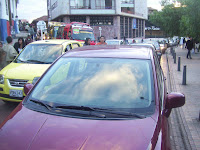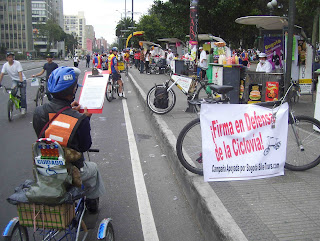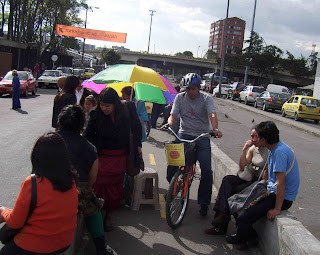
Last week, we were visited by Erik Ryberg, a lawyer and bicyclist from Tucson, Arizona, who writes a blog called (of all things)
TucsonBikeLawyer.com. Erik took a guided tour of the city's bike routes, rode on his own and rode in the famous Ciclovia. His impressions were varied - from admiration of some cycle routes and the Ciclovia, to disgust at the pollution and some unusable bike paths.
Here's our conversation:
What are your general impressions of bicycling in Bogotá?
"The first thing I noticed compared to Mexico is the number of women on bicycles. In Mexico it's very rare to see women on bicycles. In all the time in Mexico I can only remember one woman on a bicycle. Commuting. Many ride do in their Ciclovia.
"I also found the drivers really courteous. Compared to Tucson. In Tucson it's really common to find drivers going fast ride really close to you. In Tucson I was terrified of being hit from behind. In Bogotá, drivers do cut you off by turning in front of you. But being struck from behind wasn't a concern.
"I actually didn't feel less safe here than in Tucson. In lots of ways I felt more safe.
"And the Ciclorutas, given the constraints any city has, I thought they did a pretty good job. In the north they're beautiful, separated from the streets and so forth. That's not to say there aren't embarrassing places where they end, where they force you to do something dangerous, where there's a big hole in the route. I rode one where it was impossible to ride on the path because of the pedestrians. They put the cicloruta exactly where the (pedestrians) need to be. It's just a terrible design."
And how about the pollution here?
"It's horrible. It's as bad as Mexico City. Pollution here is as bad as any place I've ever been. I was in Rome in the '70s and it's as bad as that. On Saturday it was a dystopia; the cars weren't moving at all and they were belching fumes."
My observation: Well, hopefully it's not actually as bad as Mexico City. To its credit, the Colombia's state petroleum company has, very tardily, been reducing the sulfur content of the diesel fuel and the city has been trying, tho not nearly hard enough, to enforce emissions laws and to buy up and junk old, dirty buses.
I expressed to Erik my frustration that so many things here just do not function sensibly: The city builds bike paths, but some are unuseable. There's little bike parking, and the expensive, new bike parking facility built near my neighborhood has never opened, years after construction...Erik tried comforting me by comparison with Tucson:
"We have a broken system in Tucson just like you have in Bogotá. We have a Ciclovia that's supposed to happen in March and may or may not happen. I want people to know what a Ciclovia is and for them to make an informed decision about it."
But Bogotá, a city of eight million people, has no bicycle activist community! In relatively tiny Tucson, there is.
"In Tucson there's a lot of bike activists. There's a spontaneous ride every Tuesday night. The police tried to stop it, but didn't have much luck. I ended up representing a lot of people who got arrested or ticketed in that. It's not designed to aggravate drivers. We do our best to just take up one lane and stop at stop signs. We all ring our bells.
"We're winning: We're getting more and better bike infrastructure for sure. We're getting more respect from the police. When cyclists are hit by cars, the police don't automatically blame the bicyclist. There are just more and more of us. It's becoming a more legitimate way to get around town.
"You can put a bike on the bus. Tucson's buses get most places, but you have to wait about an hour."
If only that would happen in Bogotá! where increasing wealth and endless propaganda drive young people to want to buy cars. Here, unfortunately, bicycle commuters are mostly people who can't afford bus fare, much less cars.
Erik also observed something I've been griping about for years:
"The lack of bike racks around town is another issue. I saw a lot of people riding bikes, but where do they put them?"
In fact, a Bogotá law requires buildings and public parking lots to receive bicycles. But many do not. The last time I visited, not even the City Council building honored its own law.
But one thing did dazzle him: Bogotá's Ciclovia:
"I came because of the Ciclovia. It was pretty much what I expected. Although I hadn't expected the vibrancy of the whole aerobics dance thing. I'd seen the video of it, but it really helped to be there in person. I was really impressed with the skill of the people up on stage. I was really impressed with everybody. They obviously knew their jobs really well. Everybody was really happy. Everybody is always happy when they're riding bikes.
"Among bike advocates in America Peñalosa is really well known, and Bogotá's real well known as a place with a really ambitious bike route system and really ambitious Ciclovia. It'll be a shame if they continue chipping away at the Ciclovia."
(He refers to the fact that, for expansion of the Transmilenio express-bus system, the city has removed parts of the Ciclovia, including Boyaca Ave. and 26th St. - although we're pressing to get those back.)
And Erik said his experience here contradicted the popular image of Colombia
"Colombia has such a bad reputation in the states. Even now. People assume that if you're coming here, you're coming here to do cocaine. You'll get kidnapped. I rode my bike all over the place," and didn't get kidnapped!
This blog is written by Mike Ceaser of Bogota Bike Tours.






 Rush hour, but nobody's moving!
Rush hour, but nobody's moving!



 What's the lesson in this? That in the city government there are people with good intentions to promote cycling. But, somewhere between the idea and the act, something goes wrong - bureaucracy, incompetence, poor planning - whatever. To me, it also looks like yet another example of Bogotá's top-down planning practices. Did they consult with real bicycle commuters before deciding to build a parking facility whose sides are built of slats which let the often-torrential rain in? Did they consult with other mass transit bike parking facilities before deciding to build this, apparently without any plan for operating it?
What's the lesson in this? That in the city government there are people with good intentions to promote cycling. But, somewhere between the idea and the act, something goes wrong - bureaucracy, incompetence, poor planning - whatever. To me, it also looks like yet another example of Bogotá's top-down planning practices. Did they consult with real bicycle commuters before deciding to build a parking facility whose sides are built of slats which let the often-torrential rain in? Did they consult with other mass transit bike parking facilities before deciding to build this, apparently without any plan for operating it?




















